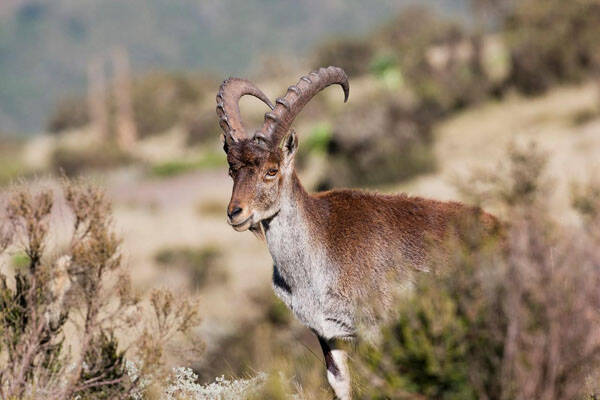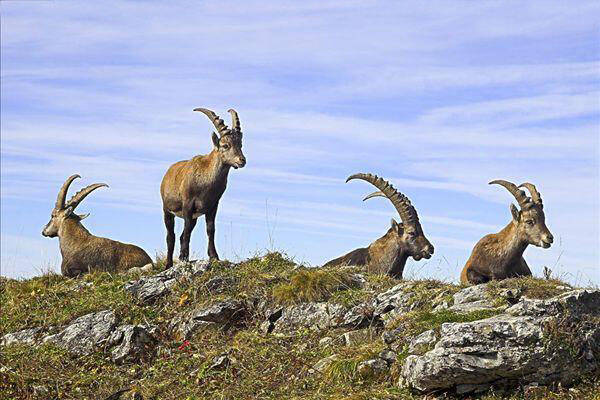Capra aegagrus
IUCN
LCBasic Information
Scientific classification
- name:Capra aegagrus
- Scientific Name:Capra aegagrus,Persian Ibex
- Outline:Ungulata
- Family:Artiodactyla Bovidae Capra
Vital signs
- length:115-117cm
- Weight:32-125kg
- lifetime:12-22years
Feature
Both sexes have distinct curved horns with notches, and males have long whiskers under their chins.
Distribution and Habitat
Origin: Distributed in Armenia, Azerbaijan, Georgia, Islamic Republic of Iran, Pakistan, Russian Federation, Turkey and Turkmenistan.
Regional extinction: Jordan, Lebanon, Syrian Arab Republic.
Wild goats live in mountains at an altitude of 500 to 6,000 meters. In summer, wild goats stay high in the mountains and feed on grass and moss; in winter, they move to lower places to avoid the thick snow.
Appearance
The wild goat is 90 cm tall at the shoulder, 115-117 cm long, and weighs 32-125 kg. Both males and females have curved horns with obvious notches, but the male goats' horns are much larger, up to 150 cm long. The fur is brown-gray, with the upper part being darker. The male has a beard and a pair of slightly curved large horns with many horizontal ridges on them, like a continuous mountain range. The male has a long beard under his chin.
Strong physique; with legs suitable for long-distance running; there are 4 toes on the feet, but the lateral toes are more degenerate than those of deer, which are suitable for running; the incisors and canines are degenerate, but the lower incisors are retained, and the lower canines are incisorized, with three pairs of incisors tilted forward and shovel-shaped. Because they feed on relatively hard plants, the premolars and molars have high crowns, the enamel is wrinkled, and the surface forms complex tooth patterns after the crowns are worn,
Details
Wild goats (scientific name: Capra aegagrus) are also known as Wild Goat and Bezoar in foreign languages. There are 7 subspecies.

Wild goats are sure-footed and have excellent balance, and can jump quickly and steadily from one rock to another. To escape from their enemies, they always choose to run to places where they are difficult to catch. If they are cornered, wild goats will turn around and fight with their enemies with their horns. Wild goats are a sure-footed animal. They can walk or run quickly across rocky areas. Male goats fight each other for the right to mate with female goats. The winners are usually the older ones, that is, those who are at least 6 years old, because their horns are the strongest. Male goats fight during the estrus period, which is generally before the breeding season, from autumn to December. During the fight, two male goats face each other, stand on their hind legs, and then slam their heads together. The base of their horns is thick, so they will not be injured. Only the winner can obtain the right to mate with the female goat and produce offspring.

The breeding season for wild goats is from late summer to early winter. Older male goats will force younger male goats into the female herd for mating during estrus. The female estrus cycle is 18 days. Female goats usually give birth to one kid. It is very common for domestic goats to give birth to twins, and the gestation period varies from breed to breed, generally between 145-152 days. The young sheep are precocious and can follow their mothers to walk a few hours after birth. They are weaned and eat grass independently about 10 months after birth. Females are sexually mature and can reproduce at about 1 year old, while males begin to develop their genitals at about 5 months old, but sexual maturity is not until 3.5-4 years old. Their lifespan is between 12-22 years old.
Although wild goats are native in some areas, they can be very destructive as invasive species. In the Galapagos Islands, foreign wild goats ate a large number of local plants, destroying the ecological balance. Later, people could only hunt them to extinction on the island to solve the problem. Due to the degradation of the habitat quality, the overall number of this species has been greatly reduced. Although the species has a wide distribution range, it occurs at a low density and is distributed in blocks. The moderate number is small and may decline rapidly and continuously within its distribution range, so it is listed as vulnerable.
Listed in the 2012 Red List of Threatened Species of the World Conservation Union (IUCN) ver 3.1 - Vulnerable (VU).
Protect wild animals and eliminate game.
Maintaining ecological balance is everyone's responsibility!








